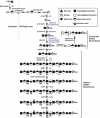Glycobiology on the fly: developmental and mechanistic insights from Drosophila
- PMID: 18824561
- PMCID: PMC2722416
- DOI: 10.1093/glycob/cwn096
Glycobiology on the fly: developmental and mechanistic insights from Drosophila
Abstract
Drosophila melanogaster offers many unique advantages for deciphering the complexities of glycan biosynthesis and function. The completion of the Drosophila genome sequencing project as well as the comprehensive catalogue of existing mutations and phenotypes have lead to a prolific database where many of the genes involved in glycan synthesis, assembly, modification, and recognition have been identified and characterized. Recent biochemical and molecular studies have elucidated the structure of the glycans present in Drosophila. Powerful genetic approaches have uncovered a number of critical biological roles for glycans during development that impact on our understanding of their function during mammalian development. Here, we summarize key recent findings and provide evidence for the usefulness of this model organism in unraveling the complexities of glycobiology across many species.
Figures



References
-
- Aoki K, Perlman M, Lim J, Cantu R, Wells L, Tiemeyer M. Dynamic developmental elaboration of N-linked glycan complexity in the Drosophila melanogaster embryo. J Biol Chem. 2007;282:9127–9142. - PubMed
-
- Boquet I, Hitier R, Dumas M, Chaminade M, Préat T. Central brain postembryonic development in Drosophila: Implication of genes expressed at the interhemispheric junction. J Neurobiol. 2000;42:33–48. - PubMed
Publication types
MeSH terms
Substances
Grants and funding
LinkOut - more resources
Full Text Sources
Molecular Biology Databases

